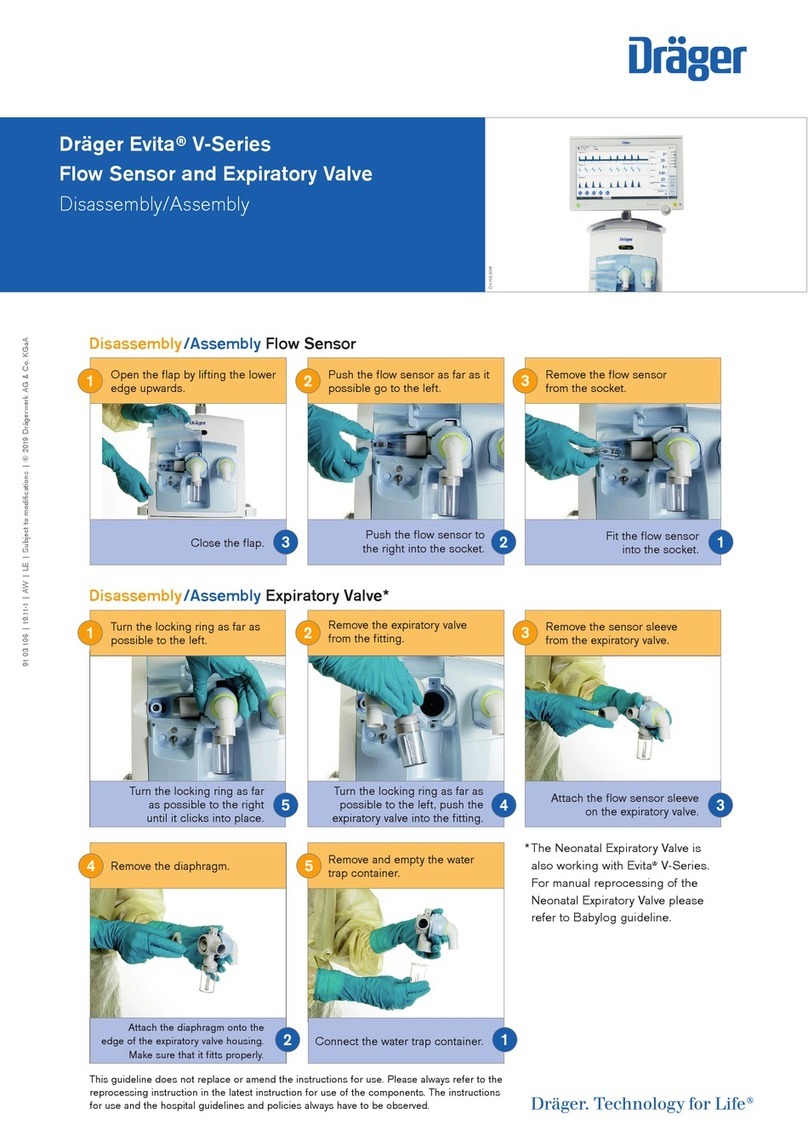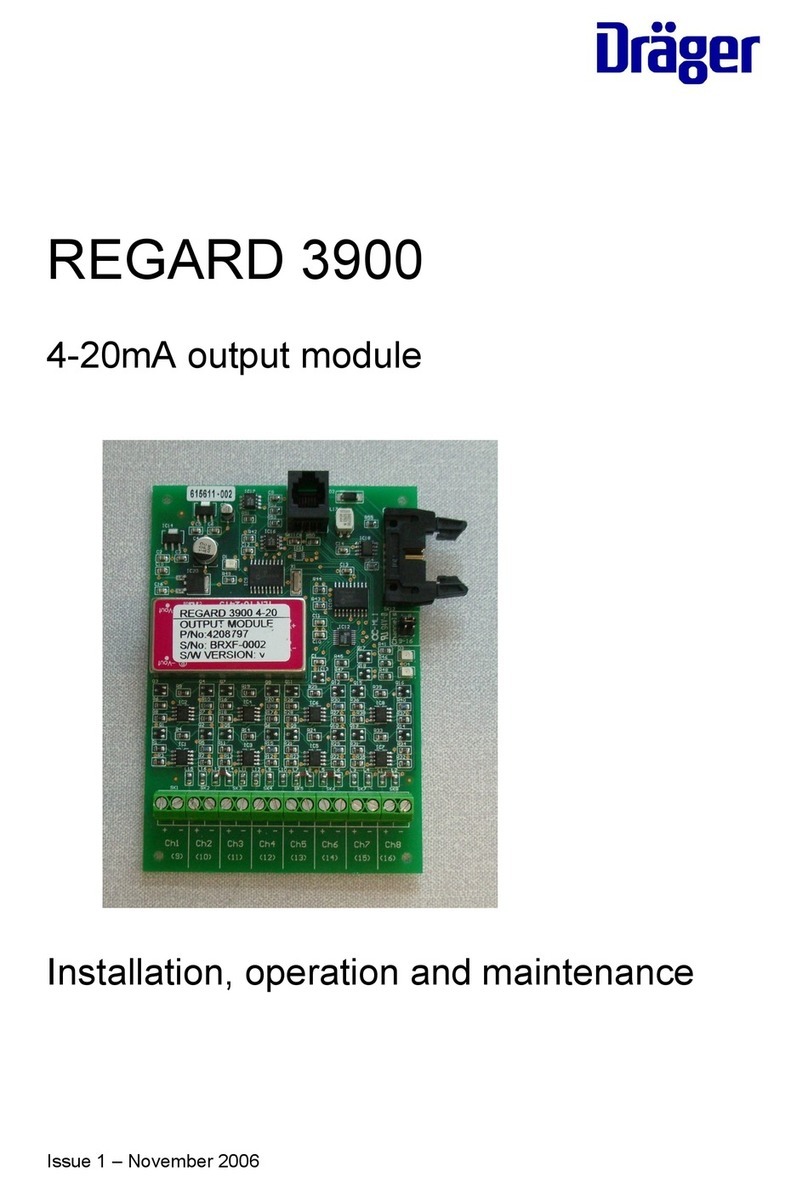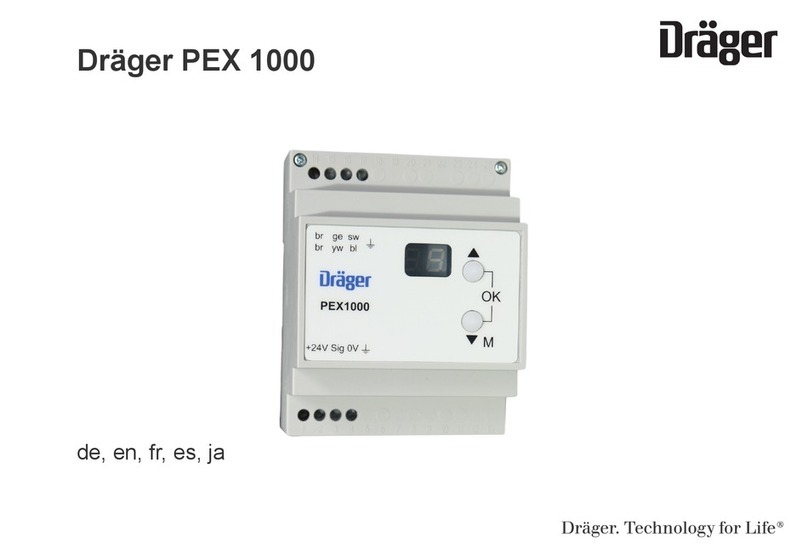PSS®and PAS®are trademarks of Dräger 3354242 (A3-D-P)
1 For your safety
1.1 General safety statements
●Before using this product, carefully read the Instructions for
Use.
●Strictly follow the Instructions for Use. The user must fully
understand and strictly observe the instructions. Use the
product only for the purposes specified in the Intended Use
section of this document.
●Do not dispose of the Instructions for Use. Ensure that they are
retained and appropriately used by the product user.
●Only fully trained and competent users are permitted to use
this product.
●Comply with all local and national rules and regulations
associated with this product.
●Only trained and competent personnel are permitted to
inspect, repair and service the product. Dräger recommends a
Dräger service contract for all maintenance activities and that
all repairs are carried out by Dräger.
●Properly trained service personnel must inspect and service
this product as detailed in the Maintenance section of this
document.
●Use only genuine Dräger spare parts and accessories, or the
proper functioning of the product may be impaired.
●Do not use a faulty or incomplete product, and do not modify
the product.
●Notify Dräger in the event of any component fault or failure.
●The air supply shall meet the requirements for breathing air
according to EN12021.
1.2 Definitions of alert icons
Alert icons are used in this document to provide and highlight text
that requires a greater awareness by the user. A definition of the
meaning of each icon is as follows:
WARNING
Indicates a potentially hazardous situation which, if not
avoided, could result in death or serious injury.
CAUTION
Indicates a potentially hazardous situation which, if not
avoided, could result in physical injury or damage to the
product or environment. It may also be used to alert against
unsafe practices.
NOTICE
Indicates additional information on how to use the product.
2 Description
2.1 Product overview
The Dräger PAS®ASV is an accessory that allows a Dräger self-
contained breathing apparatus (SCBA) to be used with an external
air source such as a factory airline or other breathing air supply
(e.g. Dräger PAS®AirPack). The PAS®ASV automatically
switches between the external air source and the breathing
apparatus air cylinder, maintaining an uninterrupted air supply to
the wearer during switching.
2.1.1 Operation
During airline use, the PAS®ASV uses the external air source as
the primary supply of breathing air to the wearer, and the breathing
apparatus air cylinder as the secondary (or back-up) supply. If the
external air source pressure remains above a preset pressure the
wearer breathes from the external air source.
If the external air source pressure drops below the preset
switching level, the PAS®ASV switches to supply the wearer from
the breathing apparatus air cylinder. The low-pressure whistle
sounds to inform the wearer that breathing air is supplied from the
air cylinder:
●If the external air source pressure recovers (increases above
the preset switching level) the PAS®ASV switches back to the
external air source and the whistle stops.
●If the external air source falls to atmospheric pressure or is
disconnected the whistle stops. The wearer continues to
breathe from the breathing apparatus air cylinder, and the
breathing apparatus operates as a self-contained set.
2.1.2 Component description
Automatic switch-over valve (Fig 1):
AL (airline) Input from an external air source.
BA (breathing apparatus) Input from the breathing
apparatus air cylinder.
LDV (lung demand valve) Output to the lung demand valve.
Belt manifold (Fig 2):
Item 1 Male quick-coupling: an input coupling for connection to
an external air source. This coupling is not available on
some chemical protection suit (CPS) variants.
Item 2 Low-pressure whistle.
Item 3 Female quick-coupling: an input/output coupling for
connection to the pass-through connection of a
chemical protection suit (CPS) or suit ventilation
device. The coupling is optional and is blanked on some
variants.
The PAS®ASV is a permanent or occasional unit:
Permanent unit (Fig 3) – the belt manifold has a clamp for
permanent connection on to the apparatus.
Occasional unit (Fig 4) – the belt manifold has a removable clip (S-
type clip shown) that can be removed or installed when required
for specific operations.
The PAS®ASV can be factory fitted or supplied as a kit. When the
PAS®ASV is supplied as a kit the procedure for fitting is described
in the assembly instructions supplied with the kit.
2.2 Intended use
The Dräger PAS®ASV provides an automatic switching function
to allow a Dräger self-contained breathing apparatus (SCBA) to be
used with an external air source to provide extended operating
time in a contaminated or oxygen deficient work area. The
PAS®ASV is used on Dräger PSS®, PAS®, and Plus Series
breathing apparatus.
2.3 Approvals
The European standards, guidelines, and directives according to
which this product is approved are specified in the declaration of
conformity (see declaration of conformity or www.draeger.com/
product-certificates).
2.4 Equipment marking
The labels on the PAS®ASV cover are described in Section 2.1.2.
The equipment label under the cover shows the following
information (examples only):
BRAC-1359 Dräger serial number
3354XXX Dräger part number
3 Use
3.1 Prerequisites
Refer also to the Instructions for Use supplied with the Dräger self-
contained breathing apparatus.
3.1.1 External air source
WARNING
The air supply shall meet the requirements for breathing air
according to EN12021. Do not use oxygen or oxygen
enriched air.
The input pressure from an external air source must not
exceed 10 bar. Higher pressures may cause breathing
difficulties for the breathing apparatus wearer.
The external air source shall provide:
●Supply pressure: 6 bar to 10 bar
●Supply flow rate: at least 550 litres/minute
3.2 Preparation for use
WARNING
The following procedures include system checks and the
acceptable test standards. Contact Dräger if the apparatus
fails to meet any of the standards or any audible air leak
can not be rectified.
NOTICE
The high-pressure whistle referred to below is the
breathing apparatus end-of service time alarm. It can be a
mechanical whistle or an electronic sounder depending on
the breathing apparatus type.
A trained and competent person must perform the following
preparation for use checks after assembly of an automatic switch-
over valve and each time before release of the equipment for
operational use to a wearer.
1. Install the air cylinder.
2. Connect the lung demand valve to the breathing apparatus.
3. Press the reset button on the lung demand valve (positive-
pressure only).
4. Open the cylinder valve. The high-pressure whistle will
momentarily sound.
5. Close the cylinder valve and carry out the functional testing
(leak test and whistle warning test) as detailed in the breathing
apparatus Instructions for Use.
6. Press the reset button on the lung demand valve (positive-
pressure only).
7. Open the cylinder valve of the breathing apparatus.
8. Open the valve of the external air source to pressurize the
system.
9. Connect the external air source to the male coupling on the belt
manifold. The low-pressure whistle will briefly sound, indicating
that the system has switched to use the external air source.
10. Check for audible air leaks.
WARNING
Do not direct the air flow on to the face, eyes or skin.
Pressurized air flow can cause serious injuries.
11. Firmly press the centre of the rubber cover of the lung demand
valve to activate the air flow for 3 to 5 seconds. Press the reset
button on the lung demand valve (positive-pressure only) to
stop the flow.
Standard: An unobstructed air flow will vent from the outlet of
the lung demand valve. The breathing apparatus pressure
reading should not change, indicating that the air is supplied by
the external air source.
12. Disconnect the external air source from the belt manifold.
13. Check for audible air leaks.
14. Close the cylinder valve.
15. Test the low-pressure whistle and automatic switch-over valve
as follows:
a. Positive-pressure lung demand valve – Cover and seal the
outlet of the lung demand valve with the ball of the hand.
Press the centre of the rubber cover to switch on the valve
and then carefully lift the hand to slowly vent the air.
b. Negative-pressure lung demand valve – Carefully press
the centre of the rubber cover to slowly vent the air.
Standard: The low-pressure whistle will sound briefly at the
preset pressure (3.5 bar to 5.5 bar), and will decay as trapped
air in the airline hose falls to zero. The breathing apparatus
pressure reading should decrease, indicating that the system
has switched to the air cylinder of the breathing apparatus.
16. Immediately stop venting:
a. Positive-pressure lung demand valve – Press the reset
button on the lung demand valve.
b. b.Negative-pressure lung demand valve – Release the
centre of the rubber cover.


































